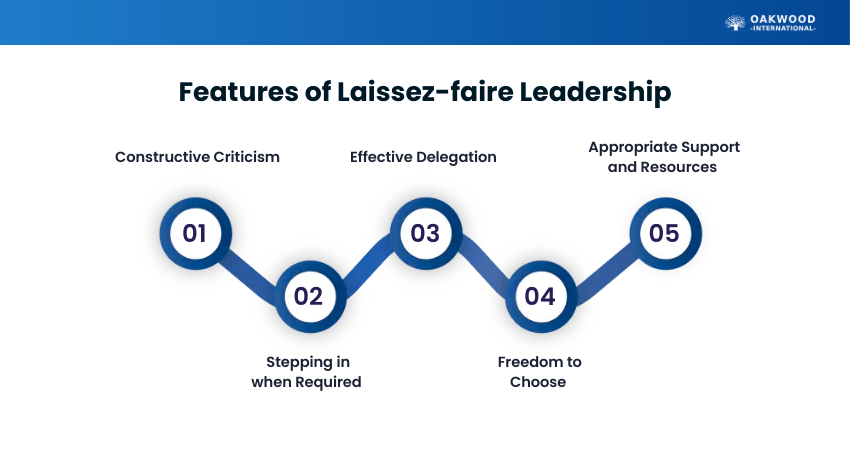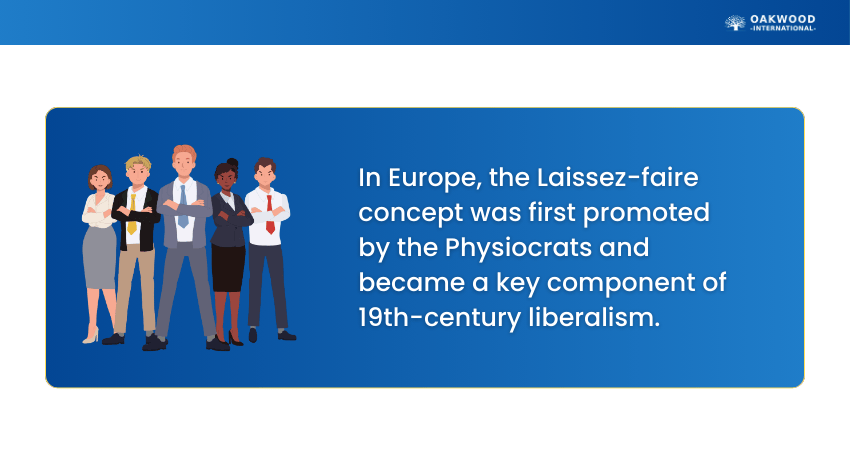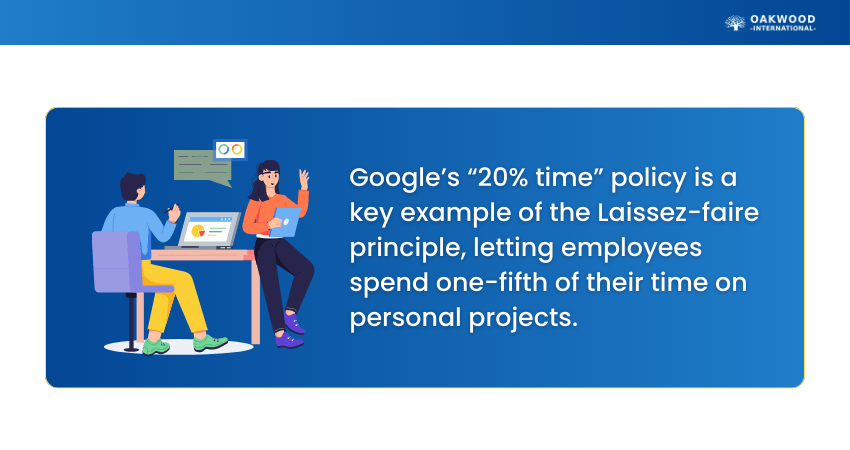Table of Contents


Picture a workplace ecosystem where the boss steps back and lets the team take the reins. Sounds like freedom, doesn't it? This is the power of the Laissez-faire Leadership style, a hands-off approach where autonomy rules, Micromanagement leaves the room and innovation thrives. Essentially, it’s the art of trusting your team to steer the ship while you guide from afar.
In this blog, we’ll break down exactly What is Laissez-faire Leadership, explore its strengths and weaknesses, and help you decide if it’s the right fit for your team. So read on and level up your managerial mettle with this freedom-driven leadership approach!
Table of Contents
What is Laissez-faire Leadership?
Is Laissez-faire Leadership Effective?
Key Features of Laissez-faire Leadership
Impact of Laissez-faire Leadership on Employees
Advantages of Laissez-faire Leadership
Disadvantages of Laissez-faire Leadership
Examples of Laissez-faire leadership
Practical Tips for Laissez-faire Leadership
Conclusion
What is Laissez-faire Leadership?
The term "Laissez-faire" means “let people do as they choose.” Unlike Micromanagement, this leadership style gives individuals the freedom to make their own decisions and manage their responsibilities. Leaders offer support, guidance, and training when needed, but trust their team to handle task execution independently.
Laissez-faire leaders are confident in delegating tasks, which is why this approach is often referred to as the delegative leadership style. While they accept that mistakes may occur during task execution but remain accountable for the team’s overall outcomes. Valuing freedom, they empower team members to make decisions and manage their work independently.
Is Laissez-faire Leadership Effective?
Laissez-faire Leadership works best when the team members are self-motivated. While mistakes can pop up, such teams typically thrive with autonomy and independence. Certain scenarios make Laissez-faire Leadership especially effective, such as in creative fields where Micromanagement can stifle innovation. This approach works well in the following industries:
1. Technology
The tech world moves fast and thrives on fresh ideas.
The leaders often hire talented Developers and Designers, then step back and let them experiment.
Steve Jobs is a famous example of a Laissez-faire Leader who gave his team space to be creative.
This led to game-changing products like the iPhone.
This approach encourages innovation and big thinking.
2. Fashion/Retail Buying
Fashion buyers must stay ahead of trends and make informed decisions as quickly as possible.
A boutique owner might trust their buyer to pick the right clothes for the next season without checking every item.
This kind of freedom lets the buyer move quickly, stay on trend and help the store stand out.
3. Advertising
In Advertising, creativity and quick thinking are key.
A Laissez-faire leader hires skilled people like Social Media experts and lets them take charge of their work.
They trust them to run campaigns, come up with fresh ideas.
They can hit targets without needing constant approvals.
Key Features of Laissez-faire Leadership
Unlike the strict, top-down style of autocratic leadership, the Laissez-faire approach is more relaxed and gives employees room to take charge. Here are some of the key features of Laissez-faire Leadership:

1. Constructive Criticism
Managers still provide constructive feedback to help employees grow. A good Laissez-faire leader can strike the balance between giving prompt feedback and letting the team make their own decisions.
2. Stepping in when Required
While this approach is hands-off by nature, a Laissez-faire leader understands when to take control. If a project goes off track or a team member is struggling, they step in to support them as needed.
3. Effective Delegation
Laissez-faire leaders know how to hand over tasks and trust their team to complete them without constant supervision. This often results in faster and more efficient work.
4. Freedom to Choose
As long as their goals are met, employees are free to choose how they complete their tasks. People who seek independence often enjoy this freedom, which in turn can increase motivation and commitment.
5. Appropriate Support and Resources
Even though employees work independently, the organisation must still provide the right tools, training, and help when needed. This ensures that the staff can do their jobs properly.
Looking to give your leadership journey the much-needed boost? Sign up for our CMI Level 5 Certificate in Management and Leadership and empower your skills!
Impact of Laissez-Faire Leadership on Employees
Some employees do particularly well in a Laissez-faire environment. These individuals often share the following qualities:
1. Experienced Employees
Laissez-faire Leadership works well for those who have a strong background in their field. For example, someone with 15 years in museum operations will likely manage tasks confidently, unlike a new hire still learning the ropes.
2. High Performance
Those who consistently meet or exceed expectations often excel with more independence. They’re comfortable taking initiative and don’t need constant oversight to deliver quality results.
3. Highly Creative
They enjoy thinking outside the box and coming up with original solutions. Unlike those who prefer strict instructions, these employees like the freedom to try new approaches to problems.
4. Self-motivated
To succeed in this setup, employees must manage their own workload, set personal deadlines, and stay on track with minimal supervision. Being proactive and organised is key.
Advantages of Laissez-faire Leadership
The hands-off approach of the Laissez-faire Leadership style can bring several advantages to the workplace. Let’s explore the main benefits of Laissez-faire Leadership:

1. Ideal Environment for Creatives
This leadership style is ideal for roles that require innovative thinking, such as product design, marketing or artistic work.
It encourages the employees to explore new ideas and take initiative.
It promotes an independent working mindset without constant supervision.
It often leads to more original and creative outcomes.
2. Loyalty to the Employer
Employees who feel trusted and valued are more likely to feel connected to the organisation.
Such a sense of trust boosts the prospect of job satisfaction.
It also encourages long-term loyalty and commitment.
Valuing individual contributions is the key to better employee engagement.
3. Accountability
This leadership style encourages employees to take full ownership of their work and results.
It inspires greater motivation and stronger commitment to their goals.
It promotes a sense of personal responsibility and seriousness.
However, senior leaders still hold ultimate accountability for the overall team performance.
Disadvantages of Laissez-faire Leadership
While the laissez-faire approach offers a multitude of benefits, it also has some potential drawbacks you must consider:
1. Lack of Structure
Too much freedom can lead to confusion.
Employees may not always know what’s expected or how to prioritise their tasks.
Leaders must therefore provide sufficient guidance to keep work on track.
But they must ensure their guidance doesn’t become overly directive.
2. Employees Feel Overwhelmed
Employees may struggle when they’re unsure where to turn for help.
If support isn't clearly offered, they might feel isolated or burdened.
To prevent this, managers must maintain open communication and intervene when necessary.
3. Work can get Duplicated
Lack of clear oversight can result in repetitive or incorrect tasks.
This can cause confusion and reduce the overall team efficiency.
It's particularly risky in structured environments such as insurance firms.
Absence of defined procedures may result in costly errors and delays.
4. Unclear Decision-making Process
Independent actions can blur the aspect of accountability for key decisions.
This may cause difficulty in tracking who is responsible for specific outcomes.
Poor communication can result in misaligned efforts.
For example, a lack of briefing between an Event Organiser and Marketing may result in off-target content.
Command respect and cultivate success. Become the leader everyone follows through our CMI Level 5 Training - Sign up now!
Examples of Laissez-faire leadership
Here are some examples of Laissez-faire Leadership in different settings:

Corporate Setting (Tech Startup CEO):
A startup founder with a technical background trusts their development team to make product decisions. They set the vision but allow the team full freedom in design, development and timelines. They intervene only if something goes off-track.
Educational Setting (University Research Supervisor):
A professor supervising PhD students gives them complete control over their research projects. The students choose topics, methodologies, and timelines, while the professor offers minimal oversight unless asked for support.
Healthcare Setting (Senior Surgeon with Experienced Team):
A senior surgeon in a teaching hospital allows experienced junior doctors and nurses to manage day-to-day patient care, only stepping in for critical decisions or if complications arise, trusting their competence.
Creative Setting (Advertising Agency Creative Director):
A creative director gives a team of designers and copywriters full autonomy to develop campaign ideas. Instead of giving specific instructions, they review the final concepts and offer feedback only when necessary.
Government Setting (Local Government Official):
A municipal leader delegates community improvement projects to department heads without closely monitoring their work. Each department manages its budget, deadlines, and priorities independently, with little interference from leadership.
Practical Tips for Laissez-faire Leadership
Here are a few strategies to support effective laissez-faire management:
Ensure Thorough Employee Onboarding
Set a strong foundation by training all new employees in your organisation’s procedures and expectations from day one. This helps them operate independently while staying aligned with your company’s values and work culture.
Offer Constructive Feedback and Guidance
Timely and thoughtful feedback can reinforce an employee’s confidence and encourage independent decision-making. Recognising well-executed tasks highlights their strengths, while pointing out areas for improvement offers direction without resorting to Micromanagement.
Introduce Motivational Incentives
To sustain engagement and productivity, consider offering more than just end-of-task recognition. Exceptional laissez-faire leaders introduce incentives throughout the workflow, such as rewarding effort, creativity, and initiative. This keeps employees motivated from start to finish.
Conclusion
The Laissez-faire Leadership style is founded on trust, independence and minimal interference. While it can inspire creativity and ownership, it also demands capable, self-driven teams to truly succeed. By gaining a good grasp on its strengths and challenges, you can decide when this hands-off approach is most effective. After all, the key lies in knowing your team and when to step back or step in.
Ready to set the next milestone in your road to leadership excellence? Sign up for our CMI Level 5 Award in Management and Leadership Training now!


 Back
Back



 Back to Catagories
Back to Catagories





 + 44 7452 122728
+ 44 7452 122728










